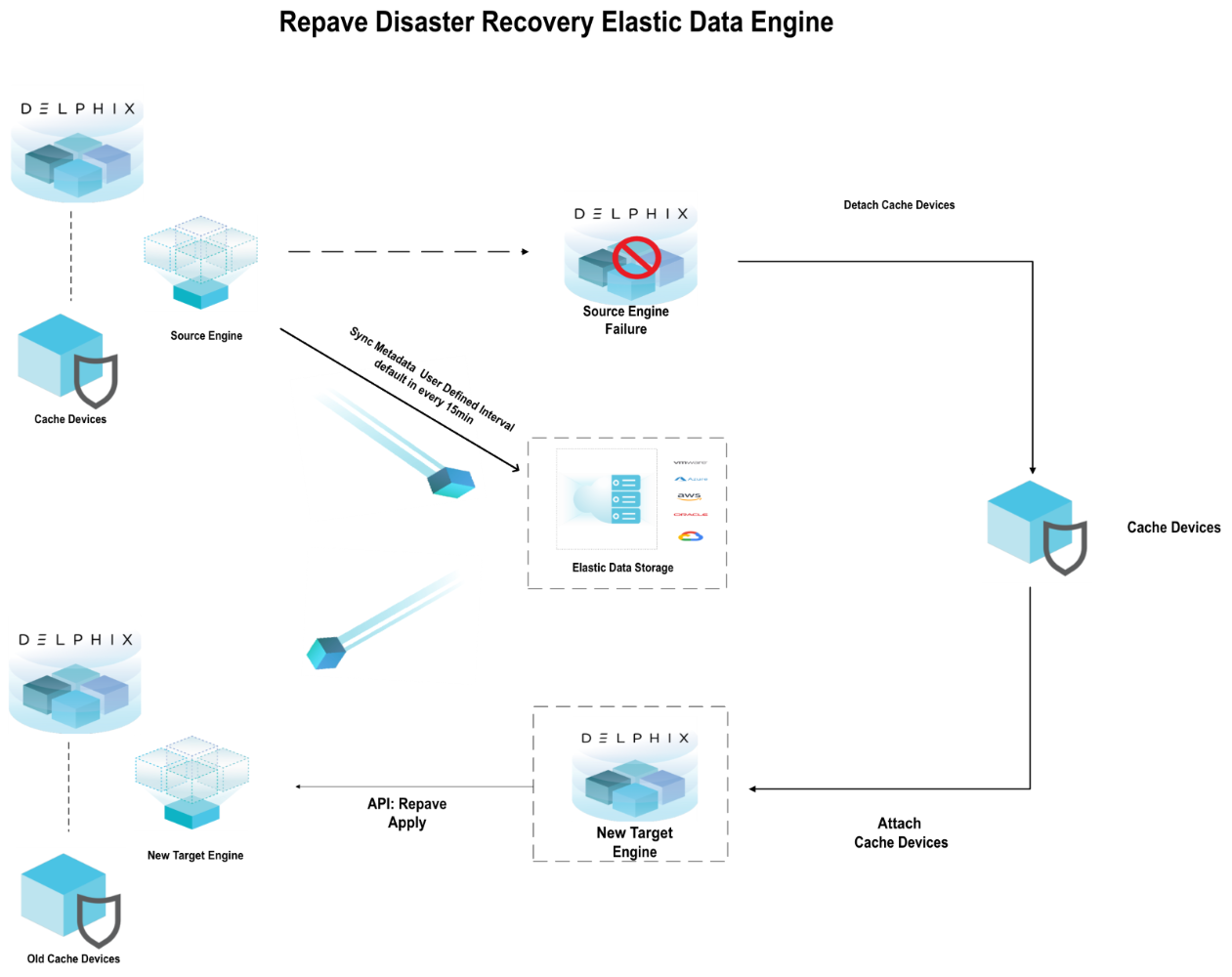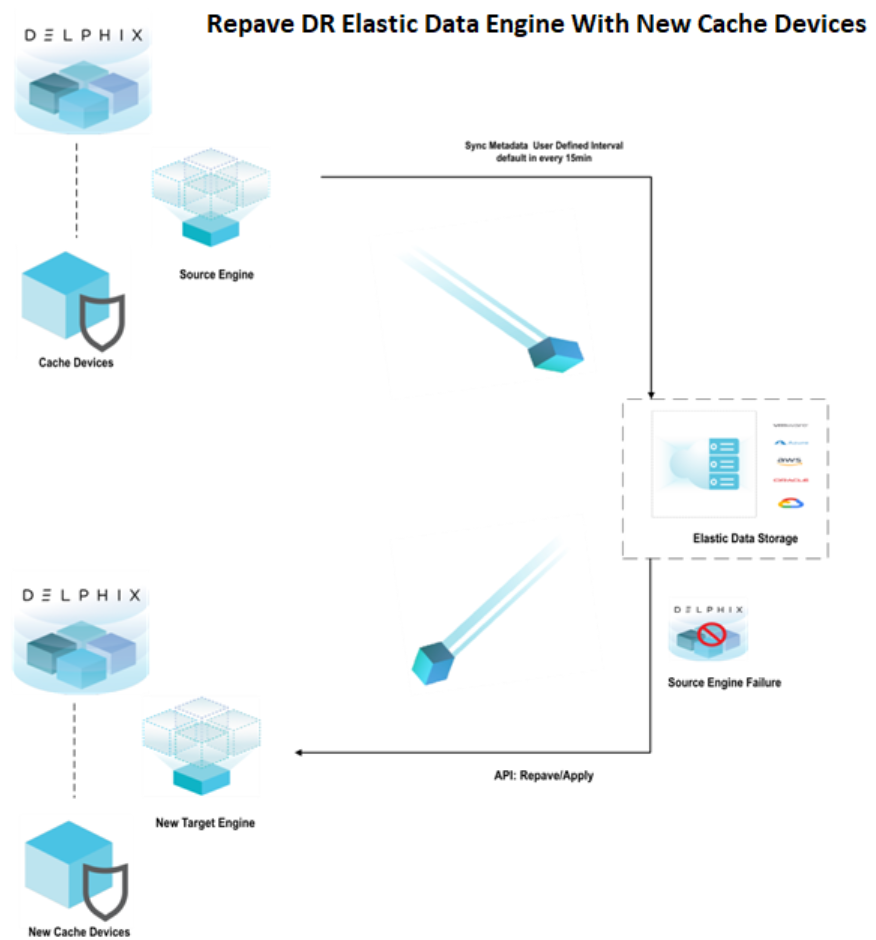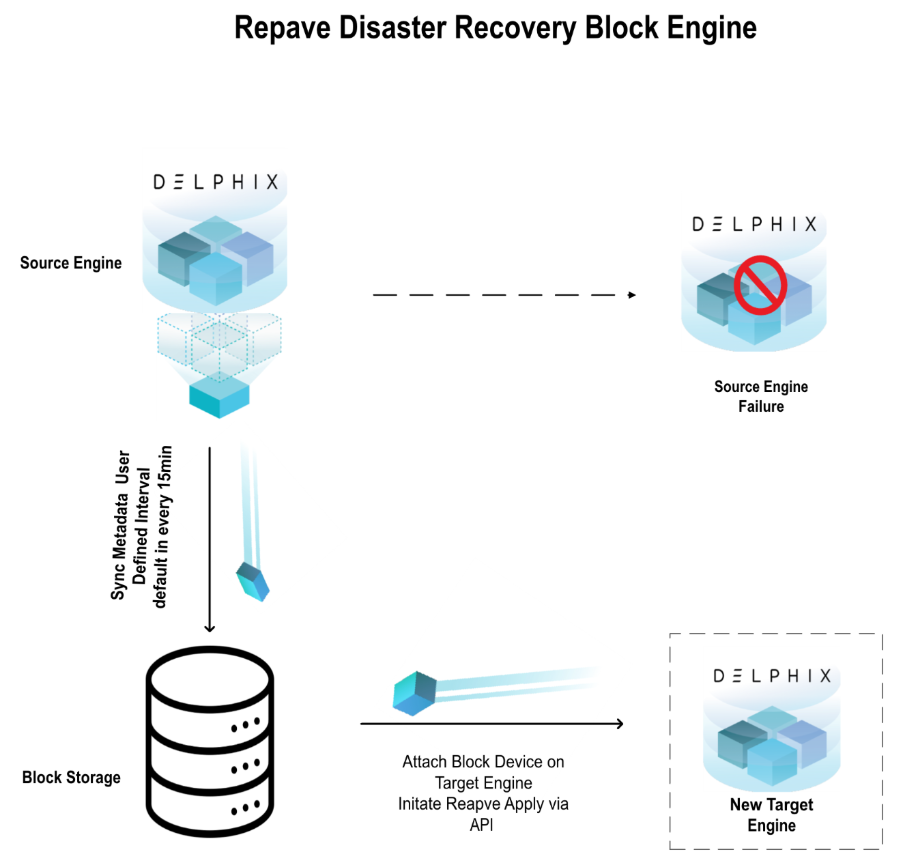Repave for Disaster Recovery
Prerequisites
-
Disaster recovery on Delphix engines is supported starting from version 2025.2.0.0.
-
The target engine must run the same version as the source engine.
Repave for disaster recovery process
Every 15 minutes, the system captures engine configuration and metadata and stores it in a directory on the same devices used by database storage. The latest collected data is available through the repave/apply API.
To recover engine data on a new target engine, ensure that the target runs the same version as the source engine.
-
For Elastic Data Engine: Use the
repave/applyAPI with the pool GUID and object storage access parameters. If you do not know the pool GUID, use therepave/listAPI to retrieve a list of Delphix engines stored in the same object storage bucket or blob with information to help identify the appropriate GUID. -
For Block Engine: Use the
repave/applyAPI. No other parameters are required.



Repave disaster recovery API calls
Retrieve storage GUID
Use POST repave/listPools on the target engine to get the database storage GUID required for repave/apply on Elastic Data engines.
-
Use the API filter to narrow results by hostname or IP address.
-
If you do not use a filter, the API returns all available storage GUIDs.
-
The response includes additional engine details such as hostname, IP address, installation time, engine UUID, and appliance version. Use this information to choose which storage GUID is appropriate.
-
Use
POST repave/preview(optional) on the target engine to preview the source engine’s summary, configurable metadata, and determine eligibility for repave on the target engine. -
Use
POST repave/applyon the target engine to start the repave process from the source engine to the target engine. -
Use
GET repaveto retrieve the current repave state, configurable metadata, and target engine summary.
-
Only the sysadmin user can run Repave APIs.
-
You can execute repave API calls through the Command Line Interface (CLI). The equivalent CLI commands are provided alongside the REST API commands.
-
Using CLI commands is recommended for executing the repave process.
REST API POST calls to execute the repave process
Establish a session
To establish a session, read the Repave Status section in Elastic Data engines.
Log in
To log in to the engine, read the Log in section in Elastic Data engines.
Back-up
Once the engine initializes, the Disaster Recovery worker runs automatically every 15 minutes. No user intervention is required.
Get pool GUID and engine details from the repave GET API
(Optional) Retrieve the domain0PoolGUID and other source engine details before executing repave/apply. As a sysadmin, you can get the domain0PoolGUID and other information by executing the Repave GET API call on the source engine.
Repave listPools:
GET http://{{delphix_engine_url}}/resources/json/delphix/listPoolsCLI equivalent:
repave/listPoolsPOST/listPools shows a list of available back-ups/domain0 engine info. You can search the available back-ups/domain0 engine information and filter by source IP address or hostname.
Request Parameters
Each cloud platform requires different parameters:
AWS S3
-
type: S3ObjectStoreRepaveListParameters
-
accessCredentials : As defined in the Repave apply section in Elastic Data engines.
-
bucket: S3 bucket name used on the source engine
-
endpoint: S3 endpoint/portal address
-
region: S3 bucket Region
-
filter:
-
type: EngineInfoFilter
-
hostname: hostname
-
IpAddresses : ip address
-
Blob:
-
type: BlobObjectStoreRepaveListParameters
-
accessCredentials : Like defined in repave apply section here: blob Access
-
container: blob container name which is used on the source engine.
-
endpoint: blob endpoint address
-
filter:
-
type: EngineInfoFilter
-
hostname: hostname
-
IpAddresses : ip address
-
GCP:
-
type: GcpObjectStoreRepaveListParameters
-
bucket: GCP bucket name used on the source engine
-
filter:
-
type: EngineInfoFilter
-
hostname: hostname
-
IpAddresses : ip address
-
OCI
-
type: OciObjectStoreRepaveListParameters
-
bucket: OCI bucket name used on the source engine
-
filter:
-
type: EngineInfoFilter
-
hostname: hostname
-
IpAddresses : ip address
-
Response
The engine info object contains some part of metadata.
CLI command of target engine for repave/listPools using AWS AccessKey:
repave listPools *> set accessCredentials.type=S3ObjectStoreAccessKey
repave listPools *> set accessCredentials.accessId=*******
repave listPools *> set accessCredentials.accessKey=******
repave listPools *> set region=us-west-2
repave listPools *> set endpoint=https://s3.us-west-2.amazonaws.com
repave listPools *> set bucket=repave-data-2
repave listPools *> set filter.type=EngineInfoFilter
repave listPools *> set filter.hostname=repavetest
repave listPools *> set filter.ipAddresses=10.110.
repave listPools *> commitOutput:
0:
type: EngineInfo
domain0PoolGUID: 3718***367*******
hostname: repavetest
installationTime: Wed Jan 22 10:25:46 PST 2025
ipAddresses: 00.00.000.92/18
uuid: ec287d******************
version: 2025.2.0.0 Repave status
To get the repave status, read the Repave Status section in Elastic Data engines.
Repave preview
Before you call this API, make sure you have the domain0PoolGUID from the source engine and other object storage profile information and credentials used for the source engine. You can also get the domain0PoolGUID from listPools.
-
To preview repave to an Elastic Data engine, read the Repave preview section in Elastic Data engines.
-
To preview repave to a block engine, read the Repave staus section in Block storage engines.
Repave apply
-
To apply repave to an Elastic Data engine, read the Repave apply section in Elastic Data engines.
The domain0PoolGUID is required for the repave/apply. To get a list of available domain0PoolGUIDs from the object storage, read the section repave/listPools API. -
To apply repave to a block engine, read the Repave apply section in Block storage engines.